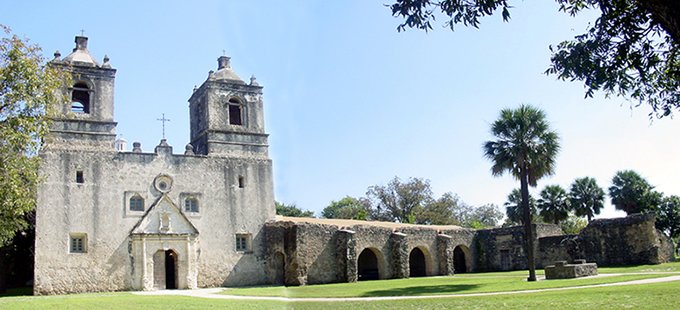

American Latino Heritage
The National Park Service and American Latino Heritage
San Antonio Missions and the Texas Frontier in the 18th Century
 |
Panoramic View of Mission Concepción, part of the San Antonio Missions National Historical Park |
For two centuries, evangelization worked with sedentary groups. In Texas, the mission system would adapt to the nomadic cultures of the southern Plains with great difficulty. The independent hunter-gatherer nomads who balked at conversion baffled the missionaries. For thousands of years, the Plains tribes had developed sophisticated survival systems and a true warrior caste unparalleled in the European military tradition. Those and other cultural traits the many Plains tribes shared enabled them to hold out against Spanish, French, and Anglo-American expansion for over three centuries. Consequently, Spanish missionaries generally concentrated their efforts on the weaker tribes, namely the so-called Coahuiltecos that stronger tribes had intimidated or defeated. Although missionaries attempted to work among Caddoan, Comanche, and Lipan Apache tribes, their efforts rarely succeeded.
Between 1690 and 1720, the Spanish centered their missionary effort in east Texas. The establishment of the presidio-mission complex at San Antonio in 1716 by Alonso de Alarcón proved to be a brilliant strategic move on Spain's part. During the 1730s and 1740s, the Spanish mission field spread from east Texas to San Antonio and La Bahia. The Spanish partially abandoned the east Texas missions and moved the missions to San Antonio. San Antonio de Valero, San Juan Capistrano, San Francisco de la Espada and Purísima Concepción formed a cluster of missions along the Río San Antonio. Supported by a Spanish population center and presidio at the Villa de San Antonio de Bexar, the area became an important trade center. Unlike east Texas, which depended on the French at Natchitoches for supplies and the presidio-mission at La Bahia, which lacked a population base save for the few dozen presidial soldiers with families and missionaries, San Antonio was comparatively self-sufficient. San Antonio Missions National Historical Park interprets the history of the Spanish missionary-military frontier as part of the national story of the United States. Long before there was an Alamo, Hispanic frontiersmen had forged a settlement that would become one of America's great cities.
<<< Previous Section Next Section>>>